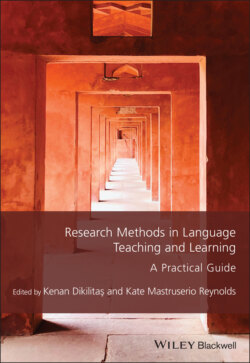Читать книгу Research Methods in Language Teaching and Learning - Группа авторов - Страница 40
Concluding Comments
ОглавлениеLanguage teaching and learning is such a broad field that the possibilities for research and researchers are seemingly endless, both in terms of what might be focused on (for example, from corrective feedback to learner identity, and from testing and assessment to teacher beliefs), and what research methodology might be adopted (for example, qualitative or quantitative, longitudinal or cross-sectional). Yet publications in our field typically (and quite reasonably) focus on the findings and (sometimes) implications of research to a far greater extent than they address the methodological processes and decisions researchers engage in. In many papers, while some reference is made to the limitations of a study, the detailed decisions and even compromises that researchers make in order to be able to proceed in as rigorous a way as possible are generally omitted (not least for reasons of word count in a journal article or book chapter!). This chapter therefore sets out to address this gap, documenting in detail the reasons why I set out to undertake a particular research investigation, the principles that underpinned my broad approach to the project, the subsequent methodological possibilities which presented themselves, and, consequently, the decisions taken to pursue the investigation in practice.
The initial impetus for the project emerged first from my own classroom experiences and the puzzles I was encountering when I reflected on the degree of unpredictability in my own classes. Reading relevant literature in the field provided a coherent conceptual framework for my questions, focusing my thinking on language classrooms as complex and, at times, messy and confusing social environments, each with their own social norms of behavior and acceptable actions and reactions. From here, it was a short step to wishing to find out how this conception might play out in practice, by investigating how a particular classroom was “socially constructed.”
The subsequent decision to pursue an ethnographic methodology thus derived from the goal of seeking to understand a classroom from the teacher’s and learners’ own perspectives, and allowing that understanding to emerge from the context and the study’s participants over time. In other words, the goals and related methodologies of ethnographic research were most in keeping with my conception of the socially constructed classroom, and with my aim to explore how the teacher and learners perceived and ascribed significance to particular events.
However, putting the principles of ethnography into practice was, and is, challenging. My decision to develop ethnographic diaries offered both methodological and theoretical flexibility – the diaries could be used alongside other research tools, such as interviews, to provide deeper understanding of the classroom through the systematic and transparent analysis and interpretation of the resultant data. Yet the decisions made when planning and implementing the ethnographic diary research carried significant implications for the data and, ultimately, the findings of the project. Even though at 4 weeks long, the project was not particularly long in terms of ethnographic approaches, it required significant participant commitment, and both the design of the project and the diaries and the way in which this was communicated and developed with participants was central to the resultant data, both in terms of its quantity and quality. Meanwhile, the participants contributed to the project with differing degrees of openness, reflectivity, and/or forgetfulness. Subsequent data analysis and interpretation thus needed to recognize the central role of myself as the researcher and the research methodology, making this transparent when disseminating the findings (Hall, 2008).
Despite these challenges, however, this ethnographic diary study offered a way of undertaking research that was truly participatory. It provided participants with a more evident sense of control within the research process, and was a “space” for teachers and learners to reveal their own perspectives on their classroom. In spite of the demands on their time and energy, the participants potentially benefited from engaging in the study and reflecting upon their own actions and contexts, becoming, to some extent, co-researchers in the research project. Thus, although the use of diaries in general, and ethnographic diaries in particular, is currently relatively rare within language teaching and learning research, more studies, particularly those that document transparently the ways in which the researcher “is the primary research instrument,” would be a valuable addition to our understanding of the complex and socially constructed nature of language classrooms.
